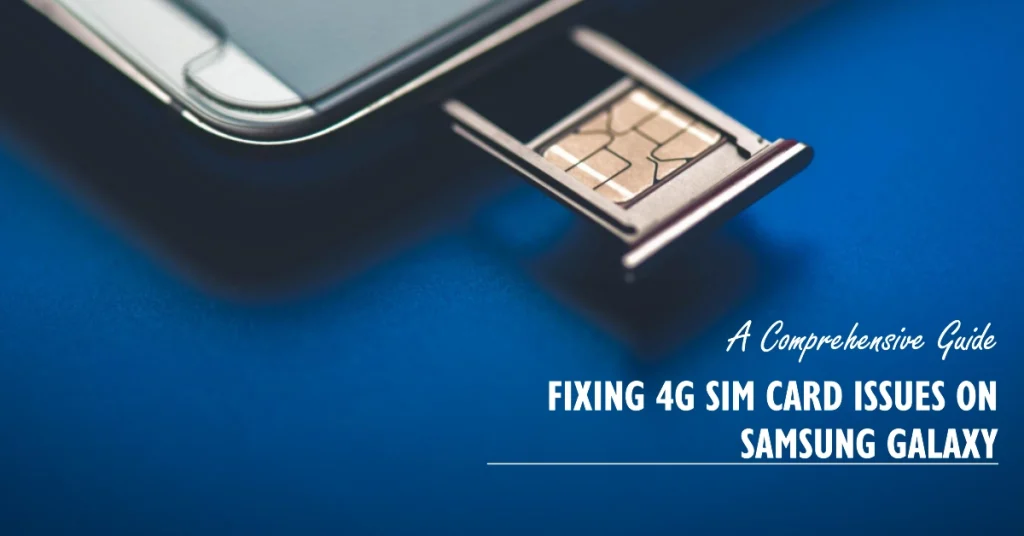In today’s fast-paced world, staying connected is crucial. 4G SIM cards play a pivotal role in enabling seamless connectivity, allowing you to make calls, send messages, and access the internet on your Samsung Galaxy smartphone. However, 4G SIM card issues can disrupt these essential connections, leaving you frustrated and disconnected.

This comprehensive guide delves into the troubleshooting process for 4G SIM card issues on Samsung Galaxy smartphones.
We’ll explore various potential causes and provide step-by-step instructions to resolve these problems effectively. Whether you’re encountering slow data speeds, no SIM card detection, or frequent network drops, this guide will empower you to regain control of your mobile connectivity.
Common 4G SIM Card Issues on Samsung Galaxy Smartphones
Before diving into troubleshooting solutions, it’s essential to identify the specific 4G SIM card issue you’re experiencing. Here are some common issues encountered by Samsung Galaxy smartphone users:
- Slow 4G data speeds: You may notice sluggish browsing, delayed app loading, or buffering issues while streaming videos.
- No SIM card detected: The phone fails to recognize the SIM card, preventing you from making calls, sending messages, or accessing mobile data.
- Frequent network drops: The phone repeatedly loses network connection, causing disruptions to calls, messaging, and internet access.
Troubleshooting Steps to Resolve 4G SIM Card Issues
Now that you’ve identified the issue, let’s embark on the troubleshooting journey:
1. Check the SIM Card and SIM Tray
A damaged or improperly inserted SIM card can be a primary culprit behind connectivity issues.
- Examine the SIM card for any visible signs of damage, such as scratches, bends, or corrosion. If the SIM card appears damaged, contact your carrier for a replacement.
- Clean the SIM card and SIM tray with a soft, dry cloth. Dirt or debris can interfere with the SIM card’s connection.
- Ensure the SIM card is properly inserted into the SIM tray. The gold-colored contacts should be facing upwards and securely aligned with the tray.
2. Restart Your Samsung Galaxy Smartphone
A simple restart can often resolve minor software glitches that might be causing connectivity issues.
- Press and hold the power button until the power options menu appears.
- Select “Restart” and wait for your phone to restart completely.
3. Toggle Airplane Mode
Sometimes, enabling and disabling Airplane Mode can refresh your phone’s network connection.
- Swipe down from the top of the screen twice to open the Quick Settings panel.
- Locate the Airplane Mode icon and tap on it to enable Airplane Mode.
- Wait for a few seconds and then tap on the Airplane Mode icon again to disable it.
4. Reset Network Settings
If the issue persists, resetting your network settings can potentially resolve any misconfigurations.
- Open the Settings app on your Samsung Galaxy smartphone.
- Navigate to “General Management” and then tap on “Reset.”
- Select “Reset network settings” and tap on “Reset settings.”
- Enter your PIN or password and tap on “Reset settings” to confirm.
5. Check for Software Updates
Outdated software can sometimes lead to compatibility issues with your SIM card and network provider.
- Open the Settings app and navigate to “Software update.”
- Tap on “Download and install” to check for available updates.
- If an update is available, follow the on-screen instructions to download and install it.
6. Contact Your Carrier
If the issue persists despite trying the above steps, it’s best to contact your mobile carrier. They may need to check your account, update your SIM card, or troubleshoot any network-related issues.
Additional Tips for Maintaining Optimal 4G SIM Card Performance
- Protect your SIM card from physical damage and exposure to extreme temperatures.
- Avoid inserting and removing the SIM card frequently.
- Keep your phone software up to date to ensure compatibility with network updates.
- Consider upgrading your SIM card if it’s an older model.
Following these troubleshooting steps and adhering to the additional tips can help effectively resolve 4G SIM card issues on your Samsung Galaxy smartphone and maintain seamless connectivity. Remember, if the problem persists, don’t hesitate to contact your mobile carrier for further assistance.
